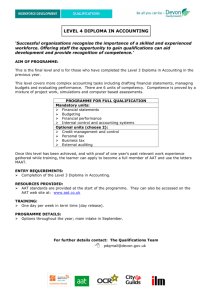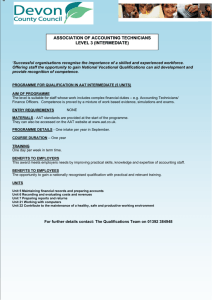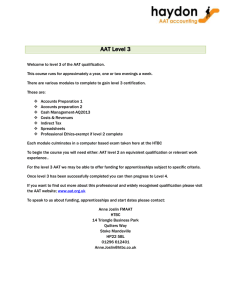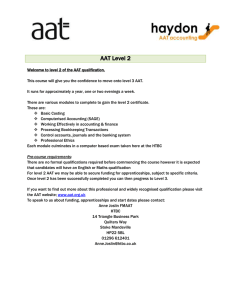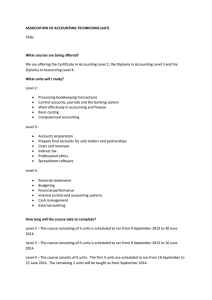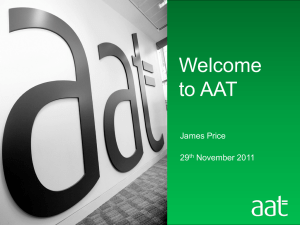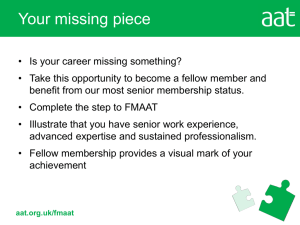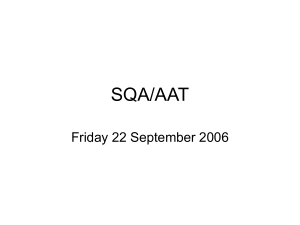Animal Assisted Therapy
advertisement
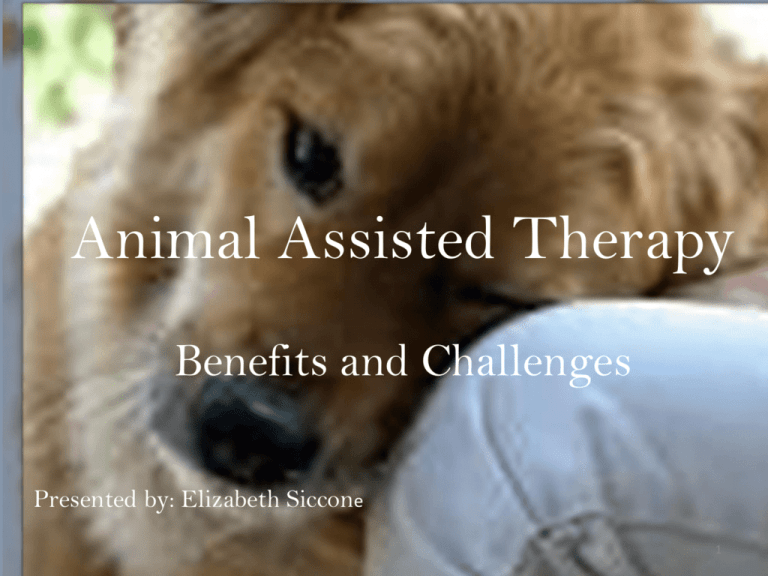
Animal Assisted Therapy Benefits and Challenges Presented by: Elizabeth Siccone 1 Therapy? 2 What is AAT Animal-assisted therapy (AAT) is formally defined by the Delta Society as “a goal- directed intervention in which an animal that meets specific criteria is an integral part of the treatment process” 3 History of Domestication 4 Domestication Changes Their Appearance Wagging tails, floppy ears… Changes their psychology as well They evolved the ability to read human gestures and this above all is not only remarkable… it is the foundation of our communication with them 5 Survival of the Friendliest 6 History of Animal Assisted Therapy Discovery that a dog’s blood pressure drops when petted was discovered in 1929 50 years later it was determined that the person's blood pressure also drops with such positive interaction. AAT becomes an accepted field of scientific study… 1980 7 Define & Distinguish: AAT/AAA Animal Assisted Therapy uses trained animals to enhance an individual’s well being: Physically Emotionally Socially *Through goal directed psychological and/or physical support directed by a human health professional for an individual and included in his/her treatment plan where progress is documented. 8 Whereas: Animal Assisted Activities: Provide interactions in a number of different of environments for the purpose of: Improving Motivation Assisting Educational Activities Enhancing Quality of Life *Essentially the interaction with the patient and the team is the same in both AAT & AAA 9 AAA AAT Casual “meet and greet” activities that involve pets visiting people Significant part of treatment for many people who are physically, socially, emotionally or cognitively challenged No specific treatment goals planned Stated goals for each session Same activity can be used with many people Detailed noted unnecessary Visit content is spontaneous Visit can be long or short as desired Individual treatment for each patient Notes on patient progress taken at each session Visit scheduled, usually at set intervals Length of visit is pre-determined to best fit needs of patient 10 Animal Assisted Activities/Therapy A highly effective form of psychotherapy intervention Some patient populations i.e. cancer, cardiac are prone to comorbidities i.e. stress, anxiety, depression 11 Negative effects of comorbidities due to immunosuppressive effects: decreased treatment adherence slowed recovery increased mortality increased cancer recurrence rates Major depression three to five times higher in oncology patients than the general population 12 “A pet is a medication without side effects that has so many benefits. I can't always explain it myself, but for years now I've seen how instances of having a pet is like an effective drug. It really does help people.” Dr. Edward Creagan Oncologist at Mayo Clinic, Rochester, MN 13 It’s chemical, not magical Stroking a pet dog decreases cortisol Increases prolactin and oxytocin: *Hormones that govern nurturing and security Increases serotonin and norepinephrine: *Neurotransmitters that boost mood. 14 THE LOOK OF LOVE IS IN THE DOG’S EYES BY JAN HOFFMAN DATE PUBLISHED APRIL 16, 2015 3:07 PM http://nyti.ms/1FZVrwL 15 Consider the implications of ‘Attachment Theory’ and pets… Dependency Acceptance without Judgment Attachment Loyalty Purposefulness Accomplishment 17 One of the most fundamental advantages of animal assisted therapy over other therapeutic modalities is that it provides the patient a much-needed opportunity to give affection as well as receive it. It is this reciprocity - rare among medical therapies - that makes AAT a unique, and valuable route to healing." Dr. Andrew Weil World-renowned leader and pioneer in the field of integrative medicine 18 Building a Safe Bridge Noted Examples In Practice: Children suffering from traumatic events including physical or sexual abuse – having an animal present makes the therapist and process seem less threatening The child can “talk to the dog” ‘Open up’ thus providing a bridge for the therapist Companion to Group Therapy Group therapy sessions where the group sits in a circle and the dog is free to roam from person to person 19 For Special Needs Kids ADHD – Oppositional Defiant Disorder Teaching How to Control Impulses Skills Transfer Clicker Training How to work with others Learning new ways to manipulate behavior Taking Turns Patience Positive Reinforcement 20 Morristown Medical Center ‘Spencer’ 21 The Star- Ledger Class with Canines Michele Hollow April 26, 2015 CBS News Cali and Cleo 22 Merlin’s Kids Service animals can be trained to meet needs of individuals with: Autistic spectrum disorders (ASD) including Asperger’s Syndrome, High and Low functioning Autism Pervasive Developmental Disorder (PDD) Attention Deficit Disorder (ADD) Attention Deficit Hyperactivity Disorder (ADHD) 23 Challenges and Considerations Non-traditional therapies Rapidly growing field Further research is paramount to practice 24 Bibliography Hare, Brian and Woods, Vanessa, Opinion: We Didn’t Domesticate Dogs. They Domesticated Us, March 03, 2013, National Geographic News: http://news.nationalgeographic.com/news/2013/03/130302-dog-domesticevolution-science-wolf-wolves-human/ Yong, Ed Origin of Domestic Dogs, November 14, 2013, The Scientist: http://www.the-scientist.com/?articles.view/articleNo/38279/title/Origin-ofDomestic-Dogs/ 25
